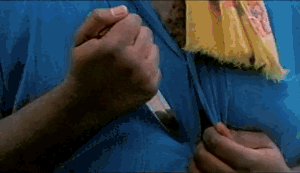On Queer Terrorism or: Corruptive tactics in Chocolate Babies
"We are black faggots with a political agenda. We're your worst nightmare."
Writing in 2000, three years after the release of Stephen Winter's Chocolate Babies (1997), Karen Booth drew attention to the fact that the majority of activists writing about AIDS during the early years of the epidemic failed to address "the racial, gender, and class politics"1 operating within public discourse at the time. The thoughts and critiques of white, educated, middle-class men were published at a disproportionate rate to those of the minority communities who were more at risk of mediated misrepresentation and public scrutiny than their vocal contemporaries.2 Subsequently, the theory, criticism and direct action that stemmed from both of the former failed to fully account for the lived experiences of bodies existing outside of these authorial identificatory confines.
Chocolate Babies is a film that deals explicitly with the marginalisation of queer black people with AIDS not only from society at large but also from mainstream discourses of AIDS activism and queer liberation. Released in 1997, 10 years after the conception of ACT UP and several years following the height of the New Queer Cinema, the film emerged at a time when continued political activity was necessary (16,000 people were being infected with HIV each day3), yet when reflection on the failures and negligence of established activist practice was possible. Aware of its liminal position between pre-AIDS naivety and post-AIDS security, Chocolate Babies presents a consciously satirical narrative that sees a group of drag queens and other social outcasts plot to overthrow their conservative, homophobic and racially insensitive politicians. In its opening scene, prior to the introduction of its central characters and their respective stories, the film stages a violent confrontation between a group of angry, non-conformist people with AIDS and their overwhelmed state counsellor. The explicit climax of this confrontation lasts just a few seconds and is visible at the head of this article. Through this momentary encounter the group's alternative form of political activism is outlined; an activism that involves the blood of the infected taking the place of the critic's ink and the knife-wielder becoming the author of change.
Words fail for Winter's queer protagonists. While accosting their counsellor with statistical evidence of their mistreatment and neglect ("Let the record show that 91 per cent of AIDS babies are black and Latino"), they are met with mumbled assurances and told to call his office; empty comments that promise the continuation of more than a decade of systemic racial and sexual invisibilisation. The black bodies of these confrontational people with AIDS fail to reap the benefits of educated analysis and objective data – a turn to physical action and interception becomes a statement on the failure of all legitimate alternatives. As the three characters draw their knives, wound their bodies and smear their blood over the counsellor's face in what might be the most abrasively political moment of any AIDS movie, the power hierarchies that determine this group's invisibility are overturned. The counsellor's face is momentarily transformed into a canvas where the material signature of these underrepresented, infected bodies is made visible. Physical retaliation is shown to be a necessary survival strategy for these bodies that do not exist in the white activist's abstract attempt at generalisations.
The transfer of blood from the bodies of the infected to the face of the counsellor also becomes a radical declaration of the necessary distinction between people with AIDS and AIDS itself. The conflation between the two has been addressed by the likes of Treichler, who outlines how a large amount of the US population were uninformed during the epidemic regarding the particularities of HIV transmission and believed it could be "caught" by acts as simple as "sitting beside an infected person on a bus."4 AIDS, it appears, was viewed not only as a medical condition but as an all-encompassing identity – an idea that is further perpetuated by scientific discourse that "implicitly and explicitly equates disease, dysfunction and pathology with racialised bodies."5 Black people with AIDS bear the brunt, then, of both a racist system of signification and a misinformed population. As the three characters of Winter's film force the counsellor into direct contact with their infected blood, they not only confront him with the potential of his own black body contracting HIV (an appeal for help made on the basis of his own exposure to the realities of mortal fragility), but make a more general statement regarding the presence of an identity outside of AIDS.
Just as the counsellor retains his individual voice and authoritative position when in contact with the virus, so do those with AIDS retain their defining characteristics and nuances. The depiction of this violent intrusion at the beginning of Chocolate Babies exposes the oppressive and prohibitive nature of the widespread understanding that people associated with AIDS were a uniform collective.
The final moment of this confrontation sees the film establish the nature of its political agenda strictly through cinematic form. As the counsellor pushes through the gang, making his way out of their presence and out of the frame, he appears to hit the camera, sending it into frenzied motion that signals the end of the opening scene. Complacent spectatorship and comfortable viewing scenarios are disrupted by such a mode of representation as the formerly observant camera suddenly embodies the heightened emotions of the moment. Chocolate Babies lets its viewers know, in its establishing moments, that our comfort is not its priority. Too much discomfort has arisen from prioritising the masses; now is the time for nuisance.
As the camera's movement comes to a stop, the characters are nominally introduced and the violent, angry, confrontational narrative continues. Throughout the film's 82 minutes, a powerful agenda of black queer militancy is sustained.
But it's all in a fragment.

